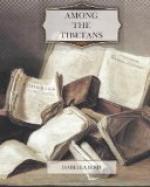The weather in Kylang breaks in the middle of September, but so fascinating were the beauties and sublimity of Nature, and the virtues and culture of my Moravian friends, that, shutting my eyes to the possible perils of the Rotang, I remained until the harvest was brought home with joy and revelry, and the flush of autumn faded, and the first snows of winter gave an added majesty to the glorious valley. Then, reluctantly folding my tent, and taking the same faithful fellows who brought my baggage from Leh, I spent five weeks on the descent to the Panjab, journeying through the paradise of Upper Kulu and the interesting native states of Mandi, Sukket, Bilaspur, and Bhaghat, and early in November reached the amenities and restraints of the civilisation of Simla.
Footnotes:
{1} Mr. Redslob said that when on different occasions he was smitten by heavy sorrows, he felt no difference between the Tibetan feeling and expression of sympathy and that of Europeans. A stronger testimony to the effect produced by his twenty-five years of loving service could scarcely be given than our welcome in Nubra. During the dangerous illness which followed, anxious faces thronged his humble doorway as early as break of day, and the stream of friendly inquiries never ceased till sunset, and when he died the people of Ladak and Nubra wept and ‘made a great mourning for him,’ as for their truest friend.
{2} For these and other curious details concerning Tibetan customs I am indebted to the kindness and careful investigations of the late Rev. W. Redslob, of Leh, and the Rev. A. Heyde, of Kylang.



